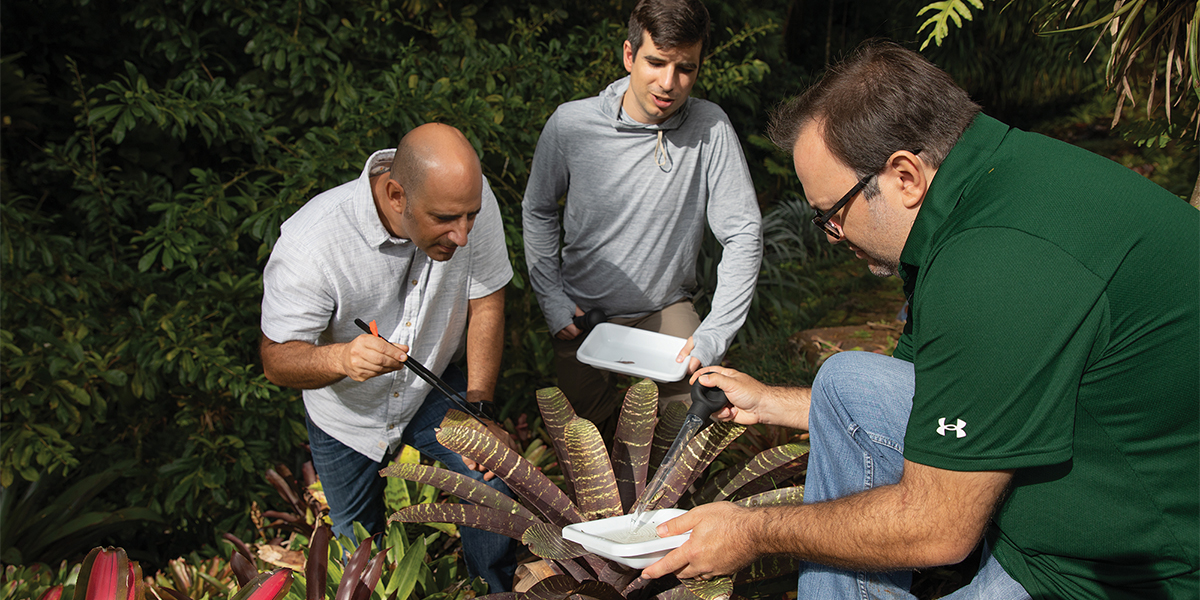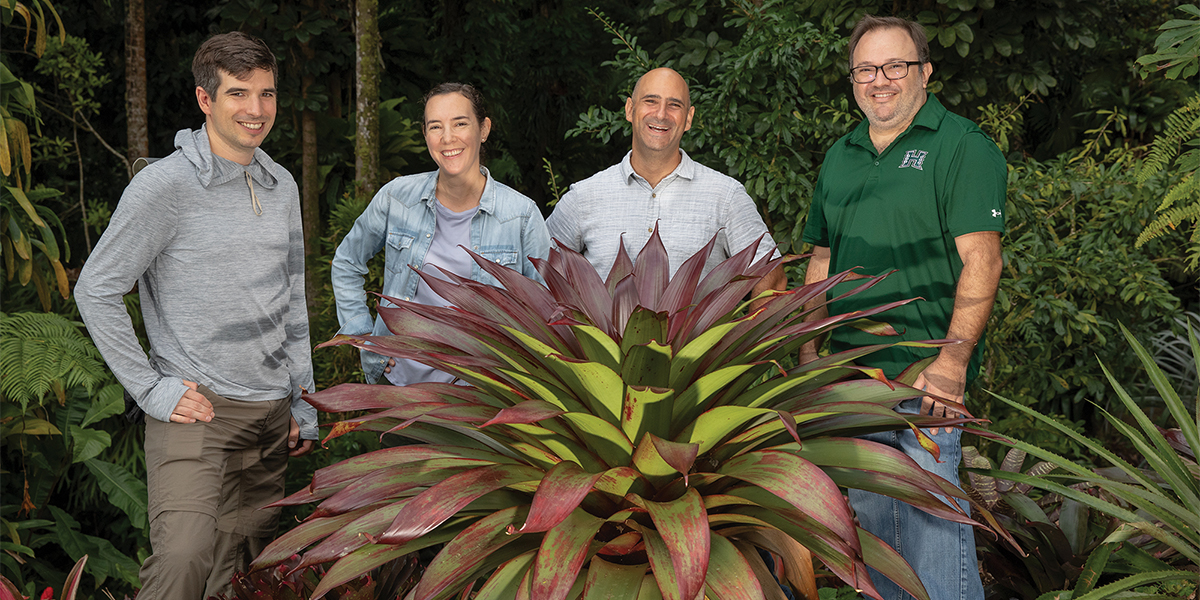University of Hawai‘i researchers have the privilege of working in a unique place. They make groundbreaking discoveries, often collaborating across disciplines and departments, that cannot occur anywhere else on Earth.
One interdisciplinary project to examine the interconnectedness of microbes in Oʻahu’s Waimea Valley brought together more than a dozen researchers from across the University of Hawaiʻi at Mānoa. It resulted in findings about microbiomes – the collection of microorganisms found in any natural habitat or body – that could shape the way we understand the intersection of the environment and human health.
The groundbreaking microbiome project funded with a $1 million gift from the W.M. Keck Foundation also resulted in not only in $2.5 million additional funding from the National Science Foundation, but a new “rule of life,” how scientists understand the interaction between microorganisms and their hosts.
The project was conducted by researchers with the Center for Microbiome Analysis through Island Knowledge & Investigation, or C-MĀIKI, an institute with collaborating faculty from different departments within UH Mānoa.
“What was really groundbreaking about the Keck award is that human health for so long has been studied in isolation, without consideration of how environmental conditions are affecting beneficial microorganisms that then affect human health,” says Nicole Hynson, C-MĀIKI director and associate professor with the Pacific Biosciences Research Center at the UH Mānoa School of Ocean and Earth Science and Technology.
Waimea Valley, on the North Shore of Oʻahu, presented researchers with a complete ecosystem that allowed them to study interactions of everything – soil, water, plants, insects, birds, fish and mammals – from the mountains, into streams and to the ocean.
They found that microbiomes were structured in a hierarchy such that soils and water had the most diverse microbes, followed by plants, and then consumers such as fish, birds and other animals.
“It’s kind of loosely this idea of you are what you eat in terms of your microbiome,” Hynson says. “However, it’s not that consumption is the only way for microbiome assembly to happen in a host. It can happen also just through interaction with other organisms, just living in the environment.
“This hierarchical nesting of the microbiome across a food web is something that we really consider new – what we’re calling a Rule of Life – for the assembly of microbiomes in nature,” she says. “And that was the impetus for this new grant from the National Science Foundation Rules of Life program.”
The NSF grant is now allowing researchers to study microbiomes in another area of Oʻahu, near Lyon Arboretum in the back of Mānoa Valley.
“The interesting thing about microbiome science is that it has completely dismissed the idea that we can continue to study human health siloed from environmental biology,” says Matthew Medeiros, who is also director of C-MĀIKI and associate professor with the PBRC. “The way forward now needs to be further integration between human health and environmental biology, and microbes are the link. And they’re the link, specifically, because of the kinds of things found during the work funded by the Keck award.
“Microbiomes are the link between human health and the environment, because you can’t ignore the environment to understand that diversity, and that diversity is the foundation for the impacts of these microbes in symbiosis on our health,” he says. “There are clear, clear, clear links to human health, and many of our researchers are looking at that explicitly.”

Unique position for world-class research
The islands’ geographic isolation and height of the volcanic mountains position UH as one of the foremost institutions in the world for astronomy. Hawaiʻi’s unique population of people from around the Pacific allows researchers at the UH Cancer Center to find new treatments.
UH also has a team of worldclass researchers whose work focuses on the Pacific Ocean, from oceanography to the Hawaiʻi Institute of Marine Biology and the Marine Mammal Research Program within SOEST.
A historic $50 million gift from Dr. Priscilla Chan and Mark Zuckerberg to SOEST supports research groups within HIMB to make meaningful progress in restoring Hawaiʻi’s ocean health. It was the largest cash gift ever received by UH.
The gift funds research and programs that document changing ocean conditions, explore solutions to support healthier ocean ecosystems, enhance coastal resilience from storms and sea-level rise, and tackle challenges to marine organisms ranging from the tiniest corals to the largest predators.
The seven-year commitment also funds research that supports healthier, more climate change resilient coral reef ecosystems.
“Hawaiʻi has one of the richest marine ecosystems in the world, and having a deeper understanding of this ecosystem is the key to preserving and protecting it,” say Mark Zuckerberg and Dr. Priscilla Chan. “We’re honored to support the University of Hawaiʻi’s conservation efforts, including its trailblazing research on coral reef restoration, the impact of climate change on coastal waters, and other areas related to the health of our oceans.”
Interim SOEST Dean Chip Fletcher noted that in addition to funding research, the gift improves support for students in overcoming obstacles to higher education.
“Through internships, mentoring, community engagement efforts and graduate research fellowships, we will grow our pool of scholars, policymakers, and conservationists from underrepresented communities around our state,” he says.
Forging a path for STEM
Donors are also investing in students who are studying science, technology, engineering and math – STEM – disciplines. The Hawai‘i Pacific Foundation has invested more than $2 million in UH programs that benefit Native Hawaiian students and their communities by empowering them to seek upstream solutions that treat the source of problems, rather than programs that address only the symptoms.
The foundation made its first gift to UH at the end of 2017: $3,000 to purchase bus passes for high school students enrolled in a program at UH West O‘ahu. Since then, it’s increased its giving each year, with gifts to UH Mānoa’s Thompson School of Social Work & Public Health, Hawaiʻinuiākea School of Hawaiian Knowledge, and College of Engineering, as well as UH West Oʻahu and the UH System.
“What we’re doing is we’re taking the helpers and the people who need help and we’re a bridge between them, finding ways to allow them to communicate better,” says retired Brig. Gen. Edwin A. “Skip” Vincent, an alumnus of the UH Mānoa Shidler College of Business and the group’s chairman. The help provided to Native Hawaiian communities ends up funneling into the mainstream communities around them, he says.
Sustainable future
Sustainability is also at the core of a $1 million gift from American AgCredit and CoBank to the College of Tropical Agriculture and Human Resources farmer training program, GoFarm Hawai‘i. It is helping program graduates grow their agricultural businesses, thereby enhancing food security while providing local fresh food and supporting economic growth in the islands. The grant rounds out American AgCredit and CoBank’s $3 million commitment to invest in food security in the islands and support young, beginning and small farmers new to agriculture.
The grant, which must be personally matched by the farmer, provides up to $25,000 per applicant that may be used to finance a land purchase, operating expenses or equipment. Along with the other gifts, it underscores the importance of UH as a major research university to Hawaiʻi’s economy.
“Economic growth comes from capital – and from human capital and innovation – and, ultimately, capital growth also comes from innovation,” says Steven Bond-Smith, an assistant professor at the University of Hawaiʻi Economic Research Organization. “It’s only sustained by having a really innovative economy.
“That innovation all builds upon prior research,” he says. “Any research activity that’s been done by universities contributes to that innovation down the line, which contributes to all these other sources of economic growth.”
Questions? / More Information
If you would like to learn how you can support UH students and programs like this, please contact us at 808 376-7800 or send us a message.
